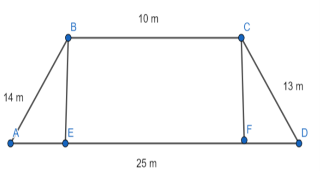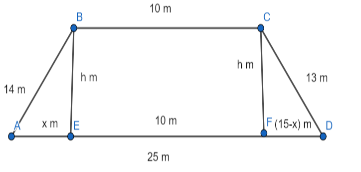
A field is in the shape of a trapezium whose parallel sides are 25 m and 10 m. The non-parallel sides are 14 m and 13 m. Find the area of the field.
Answer
589.5k+ views
Hint: Let us assume a trapezium whose parallel sides are 25 m and 10 m. The non-parallel sides are 14 m and 13 m. Now we let us assume the length of side AE is equal to x and length of side FD is equal to (15-x) m. Now let us draw a perpendicular from B to side AD at E. Now let us draw from a perpendicular from F to side AD at F. Let us assume the length of side BE is equal to h. So, we get the length of side CF is equal to h. Now in \[\Delta ABE\] and \[\Delta CFD\], we will apply Pythagoras theorem. From this we can find the value of h and x. We know that the area of trapezium whose parallel sides are equal to a and b respectively and height of trapezium is equal to h is equal to \[\dfrac{1}{2}(a+b)h\]. By using this formula, we can find the area of trapezium.
Complete step-by-step answer:
From the question, we were given that a field is in the shape of a trapezium whose parallel sides are 25 m and 10 m. The non-parallel sides are 14 m and 13 m.

Let us assume a trapezoid whose parallel sides are equal to AD and BC whose lengths are equal to 10 m and 25 m respectively and non-parallel to equal to AB and CD is equal to 14 m and 13 m respectively. Now let us draw a perpendicular from B to side AD at E. Now let us draw from a perpendicular from F to side AD at F. Now it is clear that the length of BC is equal to EF and the length of BE is equal to CF.
Now, it is clear that
\[\begin{align}
& AD=25m....(1) \\
& BC=10m....(2) \\
& AB=14m.....(3) \\
& CD=13m.....(4) \\
& BC=EF=10m....(5) \\
& BE=CF....(6) \\
\end{align}\]
From the diagram, it is clear that the sum of length of AE, length of side EF and length of side DF is equal to length of AD.
So, it is clear that
\[AD=AE+EF+DF......(7)\]
Now by substituting equation (5) and equation (6) in equation (1).
\[\begin{align}
& \Rightarrow 25=AE+EF+10 \\
& \Rightarrow AE+EF=15m....(8) \\
\end{align}\]
Let us assume the length of side AE is equal to x and the length of side EF is equal to 15-x.
Let us assume the length of BE is equal to h m.
So, now we should update the diagram of trapezium.

As \[\Delta ABE\]is a right-angled triangle at E, by using Pythagoras theorem we get
\[\begin{align}
& \Rightarrow A{{E}^{2}}+B{{E}^{2}}=A{{B}^{2}} \\
& \Rightarrow {{(h)}^{2}}+{{\left( x \right)}^{2}}={{(14)}^{2}} \\
& \Rightarrow {{h}^{2}}+{{x}^{2}}=196......(9) \\
\end{align}\]
As \[\Delta CFD\] is a right-angled triangle at F, by using Pythagoras theorem we get
\[\begin{align}
& \Rightarrow C{{F}^{2}}+F{{D}^{2}}=C{{D}^{2}} \\
& \Rightarrow {{(h)}^{2}}+{{\left( 15-x \right)}^{2}}={{(13)}^{2}} \\
& \Rightarrow {{h}^{2}}+{{(15-x)}^{2}}=169......(10) \\
\end{align}\]
Now by using equation (9) and equation (10), and subtracting, we get
\[\begin{align}
& \Rightarrow {{\left( 15-x \right)}^{2}}-{{x}^{2}}=169-196 \\
& \Rightarrow (15-2x)(15)=-27 \\
& \Rightarrow 15-2x=\dfrac{-27}{15} \\
& \Rightarrow 2x=15+\dfrac{27}{15} \\
& \Rightarrow x=\dfrac{126}{15}.....(11) \\
\end{align}\]
So, the length of side AE is equal to \[\dfrac{126}{15}m\].
Now we will substitute equation (11) in equation (9), we get
\[\begin{align}
& \Rightarrow {{h}^{2}}+{{\left( \dfrac{126}{15} \right)}^{2}}=196 \\
& \Rightarrow {{h}^{2}}=196-{{\left( \dfrac{126}{15} \right)}^{2}} \\
& \Rightarrow {{h}^{2}}=196-\dfrac{{{\left( 126 \right)}^{2}}}{225} \\
\end{align}\]
\[\begin{align}
& \Rightarrow {{h}^{2}}=\dfrac{44100-15876}{225} \\
& \Rightarrow {{h}^{2}}=\dfrac{24645}{225} \\
& \Rightarrow h=\dfrac{168}{15}....(12) \\
\end{align}\]
We know that the area of trapezium whose parallel sides are equal to a and b respectively and height of trapezium is equal to h is equal to \[\dfrac{1}{2}(a+b)h\].
So, let us assume the area of trapezium whose parallel sides are equal to 10 m and 25 m and its height is equal to \[\dfrac{168}{15}m\] is equal to A.
\[\begin{align}
& \Rightarrow A=\dfrac{1}{2}(10+25)\left( \dfrac{168}{15} \right) \\
& \Rightarrow A=196c{{m}^{2}} \\
\end{align}\]
So, the area of the trapezium field is equal to \[196c{{m}^{2}}\].
Note: Students may be confused as to why it was considered that the length of BE and length of CF are equal. As AD and BC are parallel, we get the length of BC and length of EF are equal. As BE and CF are perpendicular to both AD and BC, we can say that AD and BC are parallel. We know that the distance between two parallel lines are equal. So, it is clear that the length of AD and BC are equal. This concept should be clear to the student to solve this problem.
Complete step-by-step answer:
From the question, we were given that a field is in the shape of a trapezium whose parallel sides are 25 m and 10 m. The non-parallel sides are 14 m and 13 m.

Let us assume a trapezoid whose parallel sides are equal to AD and BC whose lengths are equal to 10 m and 25 m respectively and non-parallel to equal to AB and CD is equal to 14 m and 13 m respectively. Now let us draw a perpendicular from B to side AD at E. Now let us draw from a perpendicular from F to side AD at F. Now it is clear that the length of BC is equal to EF and the length of BE is equal to CF.
Now, it is clear that
\[\begin{align}
& AD=25m....(1) \\
& BC=10m....(2) \\
& AB=14m.....(3) \\
& CD=13m.....(4) \\
& BC=EF=10m....(5) \\
& BE=CF....(6) \\
\end{align}\]
From the diagram, it is clear that the sum of length of AE, length of side EF and length of side DF is equal to length of AD.
So, it is clear that
\[AD=AE+EF+DF......(7)\]
Now by substituting equation (5) and equation (6) in equation (1).
\[\begin{align}
& \Rightarrow 25=AE+EF+10 \\
& \Rightarrow AE+EF=15m....(8) \\
\end{align}\]
Let us assume the length of side AE is equal to x and the length of side EF is equal to 15-x.
Let us assume the length of BE is equal to h m.
So, now we should update the diagram of trapezium.

As \[\Delta ABE\]is a right-angled triangle at E, by using Pythagoras theorem we get
\[\begin{align}
& \Rightarrow A{{E}^{2}}+B{{E}^{2}}=A{{B}^{2}} \\
& \Rightarrow {{(h)}^{2}}+{{\left( x \right)}^{2}}={{(14)}^{2}} \\
& \Rightarrow {{h}^{2}}+{{x}^{2}}=196......(9) \\
\end{align}\]
As \[\Delta CFD\] is a right-angled triangle at F, by using Pythagoras theorem we get
\[\begin{align}
& \Rightarrow C{{F}^{2}}+F{{D}^{2}}=C{{D}^{2}} \\
& \Rightarrow {{(h)}^{2}}+{{\left( 15-x \right)}^{2}}={{(13)}^{2}} \\
& \Rightarrow {{h}^{2}}+{{(15-x)}^{2}}=169......(10) \\
\end{align}\]
Now by using equation (9) and equation (10), and subtracting, we get
\[\begin{align}
& \Rightarrow {{\left( 15-x \right)}^{2}}-{{x}^{2}}=169-196 \\
& \Rightarrow (15-2x)(15)=-27 \\
& \Rightarrow 15-2x=\dfrac{-27}{15} \\
& \Rightarrow 2x=15+\dfrac{27}{15} \\
& \Rightarrow x=\dfrac{126}{15}.....(11) \\
\end{align}\]
So, the length of side AE is equal to \[\dfrac{126}{15}m\].
Now we will substitute equation (11) in equation (9), we get
\[\begin{align}
& \Rightarrow {{h}^{2}}+{{\left( \dfrac{126}{15} \right)}^{2}}=196 \\
& \Rightarrow {{h}^{2}}=196-{{\left( \dfrac{126}{15} \right)}^{2}} \\
& \Rightarrow {{h}^{2}}=196-\dfrac{{{\left( 126 \right)}^{2}}}{225} \\
\end{align}\]
\[\begin{align}
& \Rightarrow {{h}^{2}}=\dfrac{44100-15876}{225} \\
& \Rightarrow {{h}^{2}}=\dfrac{24645}{225} \\
& \Rightarrow h=\dfrac{168}{15}....(12) \\
\end{align}\]
We know that the area of trapezium whose parallel sides are equal to a and b respectively and height of trapezium is equal to h is equal to \[\dfrac{1}{2}(a+b)h\].
So, let us assume the area of trapezium whose parallel sides are equal to 10 m and 25 m and its height is equal to \[\dfrac{168}{15}m\] is equal to A.
\[\begin{align}
& \Rightarrow A=\dfrac{1}{2}(10+25)\left( \dfrac{168}{15} \right) \\
& \Rightarrow A=196c{{m}^{2}} \\
\end{align}\]
So, the area of the trapezium field is equal to \[196c{{m}^{2}}\].
Note: Students may be confused as to why it was considered that the length of BE and length of CF are equal. As AD and BC are parallel, we get the length of BC and length of EF are equal. As BE and CF are perpendicular to both AD and BC, we can say that AD and BC are parallel. We know that the distance between two parallel lines are equal. So, it is clear that the length of AD and BC are equal. This concept should be clear to the student to solve this problem.
Recently Updated Pages
The number of solutions in x in 02pi for which sqrt class 12 maths CBSE

Write any two methods of preparation of phenol Give class 12 chemistry CBSE

Differentiate between action potential and resting class 12 biology CBSE

Two plane mirrors arranged at right angles to each class 12 physics CBSE

Which of the following molecules is are chiral A I class 12 chemistry CBSE

Name different types of neurons and give one function class 12 biology CBSE

Trending doubts
Fill the blanks with the suitable prepositions 1 The class 9 english CBSE

What is the full form of pH?

Write the 6 fundamental rights of India and explain in detail

Which places in India experience sunrise first and class 9 social science CBSE

What is pollution? How many types of pollution? Define it

Which are the Top 10 Largest States of India?




